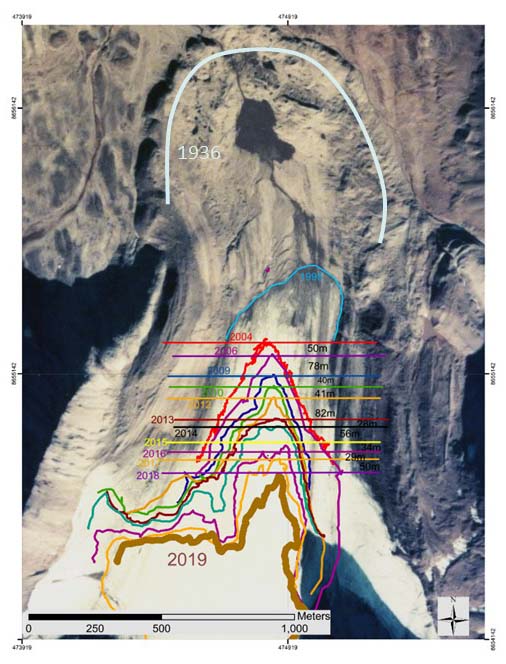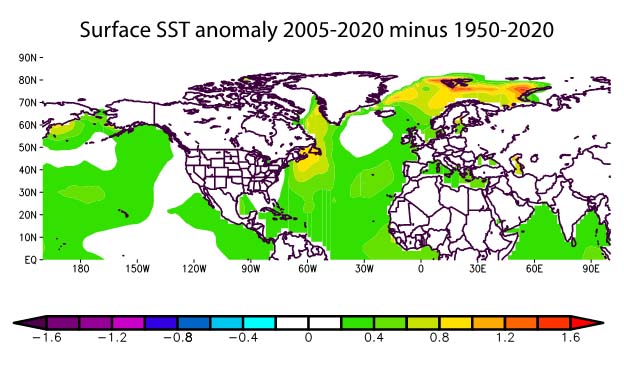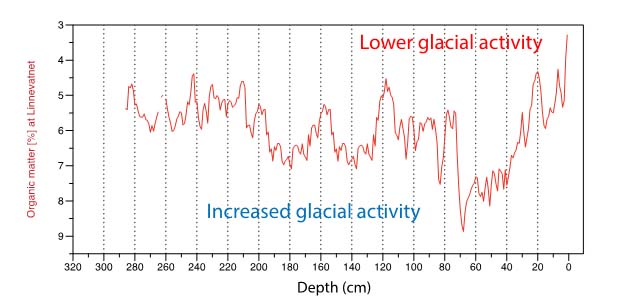The author(s) will give a talk
Unprecedented recent warmth in the context of the last 2000 years in Svalbard and the imminent disappearance of the west coast valley glacier Linnébreen
1 Bates College/University Centre in Svalbard
2 University of Massachusetts
3 University of Massachusetts
4 Goethe-University Frankfurt am Main
5 University of Iceland
Nearly 25 years ago, Svendsen and Mangerud (1997) described Holocene glacial variations in western Spitsbergen, Svalbard. Capitalizing on the Linnébreen glacier underlain by coal-bearing sandstones, they measured total organic carbon (TOC) changes on bulk sediment from nearby Linnévatnet to infer periods of glacial activity. Periods of higher TOC (glacial activity) prevailed at ~400-500AD, ~1200-1300AD and after ~1500AD-present compared to the past ~2000 years.
In Spring 2019, we collected a transect of sediment cores from Linnévatnet including a 5m sediment core on which over 100 thin sections were made to build a chronology spanning the last 2000 years. Around 7000 images were acquired at the Scanning Electron Microscope (SEM) along with µ-XRF data to obtain annual physical and geochemical variability. To explore if variations in organic matter content (through LOI) may track changes in Linnébreen glacial activity, over 300 discrete samples at 1cm resolution were also collected for loss on ignition (organic matter [%]). Results indicate that periods of elevated organic matter content broadly agree with increased glacial activity previously defined by Svendsen and Mangerud, that is around 400-500CE, 1200-1300CE and after ~1570CE.
Calcium variations from µ-XRF reveals an overall anti-phased relationship with the organic matter content, also consistent with the findings of Svendsen and Mangerud showing that higher coal content is characterized by low carbonates content. This is because when the dominant source is glacial, the meltwater carries more coal particles in the lake while weaker glacial influence leads to increased detrital carbonates from alluvial fans draining the eastern slopes of the watershed through snowmelt and/or periods of increased rainfall. Reconstruction reveals that Linnébreen glacier activity was in general stable from 700CE until 1570CE, when an abrupt increase and unprecedented glacial growth started and persisted through the 1800s. However, at the turn of the last decade, results suggest that inferred glacial activity reached unprecedented low values in the context of the last 2000 years.
Continued warming will likely result in a further weakening of the Atlantic Meridional Overturning Circulation (AMOC). Atmospheric pattern anomalies during periods of lower AMOC underscore increased southerly winds reaching more promptly Svalbard. Recent monitoring has shown that a shift in seasonal precipitation patterns has occurred with increased shoulder season rainfall and in the future will be predominantly in the form of rain, thereby preventing glacial (re)growth of low elevation glaciers such as Linnébreen, whose precocious disappearance appears imminent.
Svendsen, J.I. and Mangerud, J., 1997. Holocene glacial and climatic variations on Spitsbergen, Svalbard. The Holocene, 7(1), pp.45-57.

Fig 1.
Retreat of Linnébreen since 1936 (S. Roof, unpublished).

Fig 2.
Sea surface temperature anomaly (°C) during the rapid global warming period (since 2005) compared to 1950-2020. Note the “cold blob” in the North Atlantic, a “fingerprint” of the weakening of the AMOC. The region of Svalbard is the one warming the fastest.

Fig 3.
Organic matter [%] changes at Linnévatnet on the first 3m sediment sequence. The past decade (last ~5 cm) has seen unprecedented low values indicative of less glacial influence from Linnébreen on the sediment flux at nearby Linnévatnet.